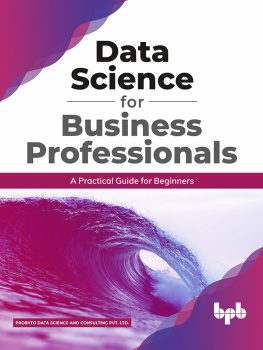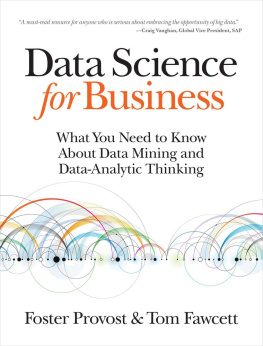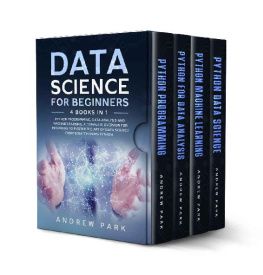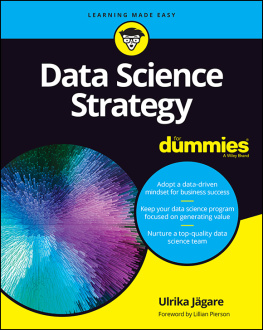Book Description
Do you wonder what the fascination is around data these days? How do we obtain insights from this data? Do you know what a data scientist does? What is artificial intelligence and machine learning? Are these the same as data science? What does it take to become a data scientist? If you have ever wondered about these questions, you have come to the right place!
There are many resources and courses online that you can use to learn more about data science, but with so much information available, it can become overwhelming. One of the best ways to learn about data science is to understand different machine learning concepts, statistics, and artificial intelligence to help you design models to perform an analysis.
This book has all the information you need to learn what data science is, and what the prerequisites are to become a data scientist. If youre a beginner or if you already have experience in data science, this book will have something for you.
In this book, you will:
The book has been structured with easy-to-understand sections to help you learn everything you need to know about data science. In this book you will learn about the prerequisites of data science and the skills you need to become a data scientist. So, what are you waiting for? Grab your copy of this comprehensive guide now!
Data Science for Beginners
Comprehensive Guide to Most Important Basics in Data Science
Copyright 2021 - All rights reserved. Alex Campbell.
The contents of this book may not be reproduced, duplicated or transmitted without direct written permission from the author.
Under no circumstances will any legal responsibility or blame be held against the publisher for any reparation, damages, or monetary loss due to the information herein, either directly or indirectly.
Legal Notice:
This book is copyright protected. This is only for personal use. You cannot amend, distribute, sell, use, quote or paraphrase any part or the content within this book without the consent of the author.
Disclaimer Notice:
Please note the information contained within this document is for educational and entertainment purposes only. Every attempt has been made to provide accurate, up to date and reliable complete information. No warranties of any kind are expressed or implied. Readers acknowledge that the author is not engaging in the rendering of legal, financial, medical or professional advice. The content of this book has been derived from various sources. Please consult a licensed professional before attempting any techniques outlined in this book.
By reading this document, the reader agrees that under no circumstances is the author responsible for any losses, direct or indirect, which are incurred as a result of the use of information contained within this document, including, but not limited to, errors, omissions, or inaccuracies.
Table of Contents
Introduction
In today's world, organizations and people focus more on big data and artificial intelligence. It may seem surprising that over 2.5 exabytes are created and collected by people and organizations each day. This means the volume of data has risen significantly over the years. Most companies have changed their business model and centered it more on data. Some organizations have also added new departments in the firm to perform data analysis. Statisticians would need to analyze the data quantitatively in the past, but this is not enough since the results of the analysis could only talk about the present. When strong computing processes, cloud technology and analytical tools came into existence; people began to use them to perform analysis. They began to develop models to analyze data.
Let us first understand what data science is before we delve into various aspects of data science. In simple terms, data science is a branch of mathematics and statistics to obtain useful and meaningful insights about the data set and trends from the raw data or information. You can process and manage the data set using programming, business and analytical skills. This sounds tough, does it not? Most people do not know how to work with data science or understand how to develop skills effectively.
This book deals with all the information needed to learn and work with data science techniques and tools. Since the world is turning to make decisions every day, it is important to learn more about what data science is and how it helps make predictions. This book aims to give you a brief of what data science is and how you approach a problem.
The field of data science goes back to its roots in statistics. Having said that, this field is a combination of programming, business acumen and statistics. It is important to learn more about each topic, so you have an idea of how you approach the learning process. The art of finding any hidden insights and trends from the data set goes way back. Ancient Egyptians analyzed census data to help them collect tax efficiently. They also used data analysis to forecast when there could be floods in the Nile. It is important to learn from past data to identify a trend or insight in the data set. This helps the business make informed decisions.
It is no longer a secret that data scientists are in demand, and if you enjoy working with data, you should pick this field. If you learn data science, you need to grab an opportunity to work in this field. Employees skilled in data science make it easier for the company to make informed decisions. The number of data science jobs has increased over the last few decades.
A data scientist is expected to develop the necessary technical and non-technical skills. If you want to excel in this field, you need to develop these skills. The book sheds some light on these skills, which will help you identify any patterns in the data set. Using these skills, you can identify hidden patterns and insights in the data set. You can also understand the different changes they may need to make in the existing products and services to improve the business's revenue.
With the information in this book, you will learn everything there is to know about data science. You will learn more about the various subjects and frameworks used in data science. So, let's get started!
Chapter One: Introduction to Data Science
Data has become the new oil, and every company, regardless of the industry, is looking for ways to manage and store large volumes of data. This was a challenge for most companies until 2010. Every company's objective was to define a framework or solution that allowed them to store large volumes of data. The introduction of Hadoop and other platforms has given organizations an easier way to store large volumes of data because of which they now focus on methods and solutions to process information. This can only be done using data science. It is important to note that data science is the future of technology. It is important to know what data science it, especially if you want to add some value to your business.
Introduction to Data Science
Data science is a mix of numerous algorithms, tools, principles, and languages to identify the hidden patterns within the variables in the data set. This may lead you to wonder how this is different from what has been done on data for years. The answer is that earlier we could only use tools and algorithms to explain the variables in the data set, but using data science, it becomes easier to predict the outcomes.












